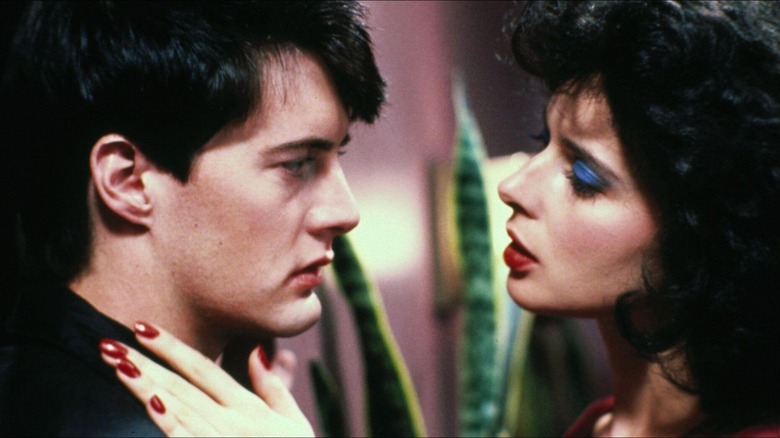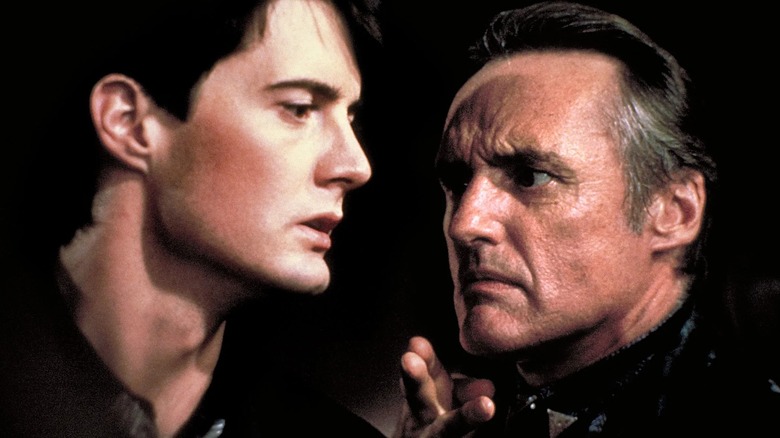The Most Confusing Parts Of David Lynch's Blue Velvet, Explained
This post contains spoilers for "Blue Velvet."
David Lynch's cinematic world tiptoes between stark reality and nightmarish dreams, where quaint, perfect lives and locales often hide Boschian hells. While some Lynchian small towns are infused with poetic romanticism despite harboring great evils (such as Twin Peaks), others, like Lumberton, weave an insincere facade with its aura of suburban bliss: a sentiment that forms the crux of Lynch's sensational, oft-misunderstood "Blue Velvet." Most of Lynch's work defies objective analysis, as the foundational ideas he embeds into his stories feel abstract and elusive, but are always tethered to reality in essential and terrifying ways. Although "Blue Velvet" helms one of the most straightforward narratives in Lynch's oeuvre — it is neither as labyrinthine nor heady as "Inland Empire" or "Mulholland Drive" — the film's graphic depictions of psychosexual impulses tend to confuse and alienate, with the merging of the real and the fantastical contributing to a disorienting experience.
The themes that run through "Blue Velvet" morph as per the lens used to experience the film, as Lynch pushes the traditional ideas of inherent meaning and causality to extremes with surrealist imagery meant to evoke a deep, subconscious reaction. This is why phrases like "What does this mean?" or "Here is what happened" are rendered futile, as logical meaning-making cannot be assigned here from start to finish. However, we can attempt to dissect the broader themes woven into "Blue Velvet," what they might mean within the context of the events that we do understand, and how Lynch uses archetypal contrasts to portray the dizzying pull of nostalgia towards a past that is not as rosy as we would like to believe. Here are some of the most confusing parts of the film, analyzed.
What does the rotting, severed ear in Blue Velvet symbolize?
The opening of "Blue Velvet" is the picture of nostalgia-laden romanticism, replete with white picket fences, vibrant red roses, and rich, beautiful lawns that contribute to the fantasy of American suburbia. This dream is shattered almost immediately when Mr. Beaumont has a stroke while watering his lawn, with the camera swerving to the rotten undergrowth concealing a grimy underbelly that is deliberately overlooked in favor of idyllic beauty. When Jeffrey Beaumont (Kyle MacLachlan) walks through the trails in his neighborhood, he discovers a severed ear infested with ants, fascinated with its presence and what it represents. Although the severed ear acts as the catalyst for Jeffrey's investigation into the matter, it also marks his journey to the other side, which lures him with promises of moralistic extremes.
Lynch ventures deeper into the ear canal to unravel what occurs next, using it as a conduit to a realm adjacent to the one we are introduced to, like a dark mirror steeped in blunt violence and strange impulses. This hidden realm exposes the hypocrisies of its twin, where this world has no space for innocence or naiveté. Jeffrey's curious tumble into this seedy underbelly can be viewed as an unsavory rite of passage where he is exposed to the hidden crevices of psychosexual violence and desire, which often go hand in hand in this world. A brand of Lynchian surrealism also pervades this reality, as Jeffrey finds himself in mundane situations that have a dreamlike tint, such as when Dean Stockwell's flamboyant character mimes to Roy Orbison's "In Dreams," which moves Jeffrey deeply to pursue elusive nostalgia. The ear is a vessel for transition into emotions that are deeply unsettling yet viscerally embedded into the human experience.
What drives Frank Booth, the culmination of unfettered id
Jeffrey's first clue to solving the mystery is lounge performer Dorothy (Isabella Rossellini), a woman he wants to desperately save from the clutches of Frank (Dennis Hopper), a sadistic aggressor in control of Dorothy's fate and autonomy. Initially, Frank emerges as the antithesis of Jeffrey's naive heroism, the prime suspect to his rookie detective, whose brand of evil feels like an aberration in a town perceived as idyllic. Frank's sexuality is only channeled through abuse, control, and rage, and the strange gas he huffs between these acts of brutality makes him feel far removed from how most humans function. This man breathes unlike anyone and channels his emotions in unpredictable extremes, exposing deep-seated psychosexual repressions and skewed notions of masculinity. Tender vulnerability is not in Frank's vocabulary — he represents unfettered evil too afraid of the light, as it might expose the fragile fallacies that contribute to his aggressive, volatile nature.
Frank's obsession with Dorothy extends to Jeffrey, as he is not only a thorn that disrupts his fantasy of control over her but also an object of Frank's repressed desires, which he expresses through bursts of aggression charged with carnal toxicity. Whenever Frank is too close to tasting something truly beautiful or transcendent, like a performance of "Blue Velvet" in the club, or the moving mime rendition of "In Dreams," he lashes out to preserve his carefully constructed reality that thrives on the Freudian pleasure principle. Although Jeffrey tastes these extremes after he is both repulsed and fascinated by Frank's existence, he must eliminate Frank's unfettered id to return to his fantastical world of white picket fences and blissful ignorance. Once the Freudian id is destroyed, the deceitful normalcy of Jeffrey's ego takes over, bringing the adventure to an end.
What do Dorothy and Sandy represent in Jeffrey's journey?
Lynch frames the two women in "Blue Velvet" through the lens of the psychoanalytic Madonna-whore complex, where women are perceived in patriarchal extremes that culminate in dehumanizing archetypes. While Dorothy represents a seductive fantasy with boundary-pushing elements that are both attractive and repulsive to Jeffrey, Sandy (Laura Dern) is the epitome of sexual innocence who embodies "the girl next door" archetype. Jeffrey flits between the two women after being introduced to the darkness of suburban reality, and his introduction to Dorothy is through a thinly disguised ruse that extends to voyeurism, where he witnesses the depravities of this world firsthand. If Jeffrey's tumble into this rabbit hole is a rite of passage, then his relationship with Dorothy denotes a transition into adulthood, replete with the understanding of intense sexual dynamics, where the line between sadomasochism and unchecked abuse blurs.
After Jeffrey hits Dorothy during sex (after she asks him to), he is crippled by the guilt and shame of the act and seeks temporary refuge in Sandy, who symbolizes an unscathed return to baseline, grounding him in the mundane. However, their relationship is also transgressive, as Dorothy already has a boyfriend, and her meetings with Jeffrey under the pretext of investigating the ear lead to something tangible. For Jeffrey, Sandy upholds the highs of the American Dream unblemished by darkness, and he returns to her in the end, where the two choose to turn a blind eye to the horrors they experienced, either directly or by proxy. Sandy's gullible (but hopeful) dream about the robins representing everlasting love is actualized, but she ignores the violence inherent in the act of the robin eating a worm in the end. In this illusory fantasy that constitutes their reality, ignorance is bliss.
Absurdity and surrealist subversion in Blue Velvet
As I mentioned earlier, there are no objective answers to explain the cyclical, interconnected realities (both fantastical) in "Blue Velvet," as heightened imagery is an intrinsic part of the film's visual and thematic fabric. Some aspects of the film are heartbreakingly sincere, such as Sandy's dream of darkness dissipating with the arrival of robins, while others underline the cruel illusions of lived-out suburban fantasies that keep its traumas and transgressions hidden beneath the undergrowth. These predatory, bug-like forces lurk beneath the facade, and people like Jeffrey often venture into these underbellies while pretending to be someone they are not, such as his ruse of being an exterminator when he investigates Dorothy's apartment. Over time, these bug metaphors become more pronounced, with the yellow man's presence that hovers in the fringes until he is squashed towards the end.
Jeffrey, who needs to step up after his father's stroke, gets the opportunity to peer into the abyss and innately understand the extremes of human nature. However, he is far from a mute observer — he is an active participant who is caught between being man and beast, where redemption only comes after he uproots evil and re-assimilates into the fantasy of normalcy. Dorothy is also reunited with her son, but her husband's murder, along with Frank's brutality, will haunt her, as society is harsh and unkind to victims of patriarchal abuse. These subversions are designed to unsettle, as people cannot emerge unscathed after a journey that forever alters the psychosexual landscape of their identity, which we use as a tool to decode and perceive others.
The comfort of the blue velvet is only temporary, as it also carries markers of violence: a constant reminder of the monstrosities of fellow man, and that of our own.




